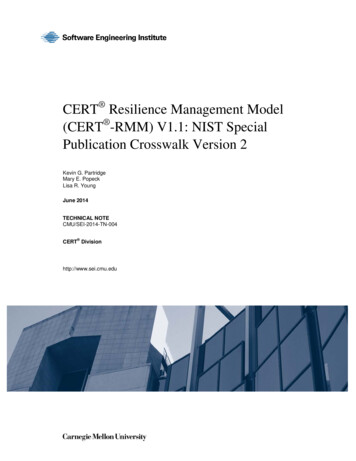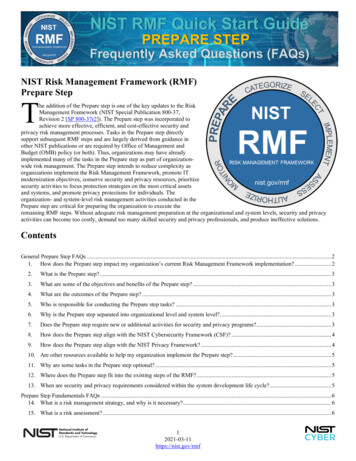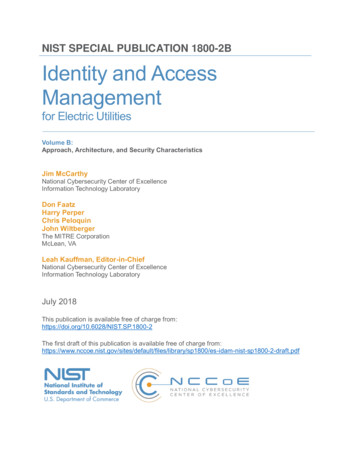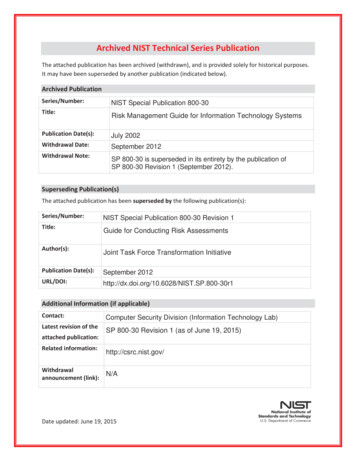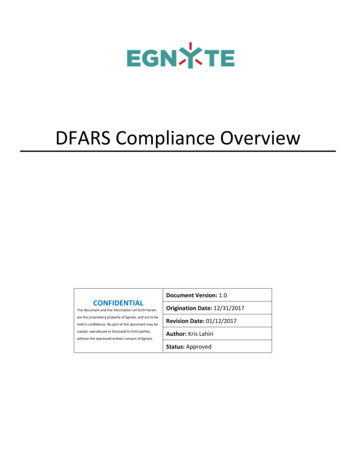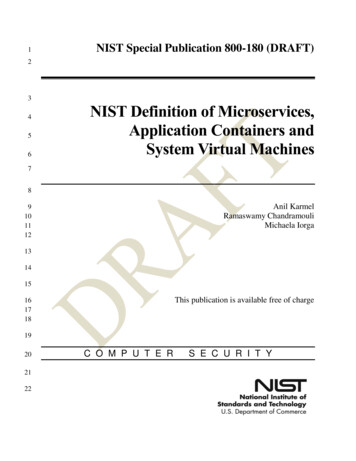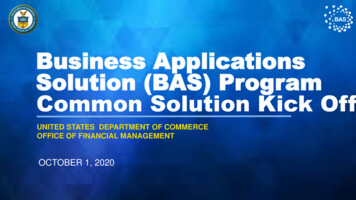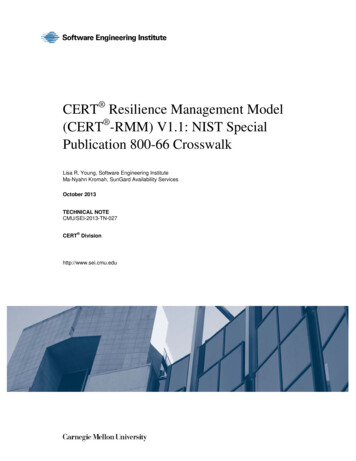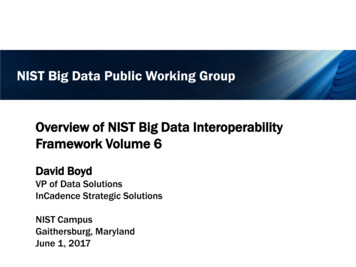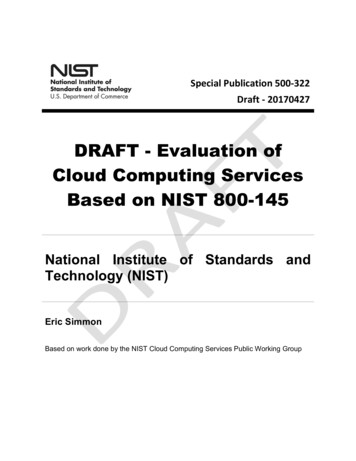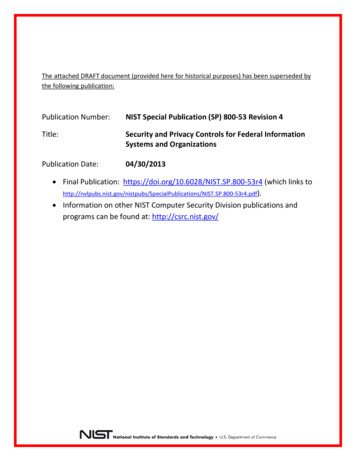
Transcription
The attached DRAFT document (provided here for historical purposes) has been superseded bythe following publication:Publication Number:NIST Special Publication (SP) 800-53 Revision 4Title:Security and Privacy Controls for Federal InformationSystems and OrganizationsPublication Date:04/30/2013 Final Publication: https://doi.org/10.6028/NIST.SP.800-53r4 (which links ions/NIST.SP.800-53r4.pdf). Information on other NIST Computer Security Division publications andprograms can be found at: http://csrc.nist.gov/
The following information was posted with the attached DRAFT document:Feb. 28, 2012SP 800-53 Rev. 4DRAFT Security and Privacy Controls for Federal Information Systems andOrganizations (Initial Public Draft)NIST announces the Initial Public Draft of Special Publication (SP) 800-53, Revision 4, Security andPrivacy Controls for Federal Information Systems and Organizations. Special Publication 800-53,Revision 4, represents the culmination of a year-long initiative to update the content of the securitycontrols catalog and the guidance for selecting and specifying security controls for federalinformation systems and organizations. The project was conducted as part of the Joint Task ForceTransformation Initiative in cooperation and collaboration with the Department of Defense, theIntelligence Community, the Committee on National Security Systems, and the Department ofHomeland Security. The proposed changes included in Revision 4 are directly linked to the currentstate of the threat space (i.e., capabilities, intentions, and targeting activities of adversaries) and theattack data collected and analyzed over a substantial time period. In particular, the major changes inRevision 4 include: New security controls and control enhancements; Clarification of security control requirements and specification language; New tailoring guidance including the introduction of overlays; Additional supplemental guidance for security controls and enhancements; New privacy controls and implementation guidance; Updated security control baselines; New summary tables for security controls to facilitate ease-of-use; and Revised minimum assurance requirements and designated assurance controls.Many of the changes were driven by particular cyber security issues and challenges requiringgreater attention including, for example, insider threat, mobile and cloud computing, applicationsecurity, firmware integrity, supply chain risk, and the advanced persistent threat (APT). In mostinstances, with the exception of the new privacy appendix, the new controls and enhancements arenot labeled specifically as “cloud” or “mobile computing” controls or placed in one section of thecatalog. Rather, the controls and enhancements are distributed throughout the control catalog invarious families and provide specific security capabilities that are needed to support those newcomputing technologies and computing approaches. The breadth and depth of the security andprivacy controls in the control catalog must be sufficiently robust to protect the wide range ofinformation and information systems supporting the critical missions and business functions of thefederal government—from the Department of Homeland Security, to the DoD warfighters, to theFederal Aviation Administration, to the Social Security Administration. As the federal governmentcontinues to implement its unified information security framework using the core publicationsdeveloped under the Joint Task Force, there is also a significant transformation underway in howfederal agencies authorize their information systems. Near real-time risk management and theability to design, develop, and implement effective continuous monitoring programs, depends firstand foremost, on the organization’s ability to develop a strong information technologyinfrastructure—in essence, building stronger, more resilient information systems using systemcomponents with sufficient security capability to protect core missions and business functions. Thesecurity and privacy controls in this publication, along with the flexibility inherent in theimplementation guidance, provide the requisite tools to implement effective, risk-based, cybersecurity programs—capable of addressing the most sophisticated of threats on the horizon.Public comment period: February 28th through April 6th, 2012.Public comment period: February 28th through April 6th, 2012. This will be the only commentperiod. Publication of the final document is anticipated in July 2012. Comments can be sent to:
sec-cert @ nist.gov.To support the public review process, NIST will publish a markup version of Appendices D, F and G.This will help organizations plan for any future update actions they may wish to undertake afterRevision 4 is finalized. There will not be any markups provided for the main chapters or the otherappendices.
NIST Special Publication 800-53Revision 4Security and Privacy Controlsfor Federal Information Systemsand OrganizationsJOINT TASK FORCETRANSFORMATION INITIATIVEINFORMATIONS E C U R I T YINITIAL PUBLIC DRAFTComputer Security DivisionInformation Technology LaboratoryNational Institute of Standards and TechnologyGaithersburg, MD 20899-8930February 2012U.S. Department of CommerceJohn E. Bryson, SecretaryNational Institute of Standards and TechnologyPatrick D. Gallagher, Under Secretary for Standards and Technologyand Director
Special Publication 800-53Security and Privacy Controls for Federal Information Systems and OrganizationsReports on Computer Systems TechnologyThe Information Technology Laboratory (ITL) at the National Institute of Standards andTechnology (NIST) promotes the U.S. economy and public welfare by providing technicalleadership for the nation’s measurement and standards infrastructure. ITL develops tests, testmethods, reference data, proof of concept implementations, and technical analyses to advance thedevelopment and productive use of information technology. ITL’s responsibilities include thedevelopment of management, administrative, technical, and physical standards and guidelines forthe cost-effective security and privacy of other than national security-related information infederal information systems. The Special Publication 800-series reports on ITL’s research,guidelines, and outreach efforts in information system security, and its collaborative activitieswith industry, government, and academic organizations.PAGE ii
Special Publication 800-53Security and Privacy Controls for Federal Information Systems and OrganizationsAuthorityThis publication has been developed by NIST to further its statutory responsibilities under theFederal Information Security Management Act (FISMA), Public Law (P.L.) 107-347. NIST isresponsible for developing information security standards and guidelines, including minimumrequirements for federal information systems, but such standards and guidelines shall not apply tonational security systems without the express approval of appropriate federal officials exercisingpolicy authority over such systems. This guideline is consistent with the requirements of theOffice of Management and Budget (OMB) Circular A-130, Section 8b(3), Securing AgencyInformation Systems, as analyzed in Circular A-130, Appendix IV: Analysis of Key Sections.Supplemental information is provided in Circular A-130, Appendix III, Security of FederalAutomated Information Resources.Nothing in this publication should be taken to contradict the standards and guidelines mademandatory and binding on federal agencies by the Secretary of Commerce under statutoryauthority. Nor should these guidelines be interpreted as altering or superseding the existingauthorities of the Secretary of Commerce, Director of the OMB, or any other federal official.This publication may be used by nongovernmental organizations on a voluntary basis and is notsubject to copyright in the United States. Attribution would, however, be appreciated by NIST.NIST Special Publication 800-53, 375 pages(February 2012)CODEN: NSPUE2Certain commercial entities, equipment, or materials may be identified in this document in order todescribe an experimental procedure or concept adequately. Such identification is not intended to implyrecommendation or endorsement by NIST, nor is it intended to imply that the entities, materials, orequipment are necessarily the best available for the purpose.There may be references in this publication to other publications currently under development by NISTin accordance with its assigned statutory responsibilities. The information in this publication, includingconcepts and methodologies, may be used by federal agencies even before the completion of suchcompanion publications. Thus, until each publication is completed, current requirements, guidelines,and procedures, where they exist, remain operative. For planning and transition purposes, federalagencies may wish to closely follow the development of these new publications by NIST.Organizations are encouraged to review all draft publications during public comment periods andprovide feedback to NIST. All NIST publications, other than the ones noted above, are available athttp://csrc.nist.gov/publications.Public comment period: February 28 through April 6, 2012National Institute of Standards and TechnologyAttn: Computer Security Division, Information Technology Laboratory100 Bureau Drive (Mail Stop 8930) Gaithersburg, MD 20899-8930Electronic mail: sec-cert@nist.govPAGE iii
Special Publication 800-53Security and Privacy Controls for Federal Information Systems and OrganizationsCompliance with NIST Standards and GuidelinesIn accordance with the provisions of FISMA,1 the Secretary of Commerce shall, on the basis ofstandards and guidelines developed by NIST, prescribe standards and guidelines pertaining tofederal information systems. The Secretary shall make standards compulsory and binding to theextent determined necessary by the Secretary to improve the efficiency of operation or security offederal information systems. Standards prescribed shall include information security standardsthat provide minimum information security requirements and are otherwise necessary to improvethe security of federal information and information systems. Federal Information Processing Standards (FIPS) are approved by the Secretary ofCommerce and issued by NIST in accordance with FISMA. FIPS are compulsory andbinding for federal agencies.2 FISMA requires that federal agencies comply with thesestandards, and therefore, agencies may not waive their use. Special Publications (SPs) are developed and issued by NIST as recommendations andguidance documents. For other than national security programs and systems, federalagencies must follow those NIST Special Publications mandated in a Federal InformationProcessing Standard. FIPS 200 mandates the use of Special Publication 800-53, asamended. In addition, OMB policies (including OMB Reporting Instructions for FISMAand Agency Privacy Management) state that for other than national security programsand systems, federal agencies must follow certain specific NIST Special Publications.3 Other security-related publications, including NIST interagency reports (NISTIRs) andITL Bulletins, provide technical and other information about NIST's activities. Thesepublications are mandatory only when specified by OMB. Compliance schedules for NIST security standards and guidelines are established byOMB in policies, directives, or memoranda (e.g., annual FISMA Reporting Guidance).41The E-Government Act (P.L. 107-347) recognizes the importance of information security to the economic andnational security interests of the United States. Title III of the E-Government Act, entitled the Federal InformationSecurity Management Act (FISMA), emphasizes the need for organizations to develop, document, and implement anorganization-wide program to provide security for the information systems that support its operations and assets.2The term agency is used in this publication in lieu of the more general term organization only in those circumstanceswhere its usage is directly related to other source documents such as federal legislation or policy.3While federal agencies are required to follow certain specific NIST Special Publications in accordance with OMBpolicy, there is flexibility in how agencies apply the guidance. Federal agencies apply the security concepts andprinciples articulated in the NIST Special Publications in accordance with and in the context of the agency’s missions,business functions, and environment of operation. Consequently, the application of NIST guidance by federal agenciescan result in different security solutions that are equally acceptable, compliant with the guidance, and meet the OMBdefinition of adequate security for federal information systems. Given the high priority of information sharing andtransparency within the federal government, agencies also consider reciprocity in developing their information securitysolutions. When assessing federal agency compliance with NIST Special Publications, Inspectors General, evaluators,auditors, and assessors consider the intent of the security concepts and principles articulated within the specificguidance document and how the agency applied the guidance in the context of its mission/business responsibilities,operational environment, and unique organizational conditions.4Unless otherwise stated, all references to NIST publications in this document (i.e., Federal Information ProcessingStandards and Special Publications) are to the most recent version of the publication.PAGE iv
Special Publication 800-53Security and Privacy Controls for Federal Information Systems and OrganizationsAcknowledgementsThis publication was developed by the Joint Task Force Transformation Initiative InteragencyWorking Group with representatives from the Civil, Defense, and Intelligence Communities in anongoing effort to produce a unified information security framework for the federal government.The National Institute of Standards and Technology wishes to acknowledge and thank the seniorleaders from the Departments of Commerce and Defense, the Office of the Director of NationalIntelligence, the Committee on National Security Systems, and the members of the interagencytechnical working group whose dedicated efforts contributed significantly to the publication. Thesenior leaders, interagency working group members, and their organizational affiliations include:U.S. Department of DefenseOffice of the Director of National IntelligenceTeresa M. TakaiDoD Chief Information OfficerAdolpho Tarasiuk Jr.Assistant Director of National Intelligence andIntelligence Community Chief InformationOfficerRichard HaleDeputy Chief Information Officer for Identityand Information AssuranceCharlene LeubeckerDeputy Intelligence Community ChiefInformation OfficerDominic CussattActing Director Information Assurance Policyand StrategyCatherine A. HensonDirector, Data ManagementKurt EleamRoger CaslowPolicy AdvisorChief, Risk Management and InformationSecurity Programs DivisionNational Institute of Standards and TechnologyCommittee on National Security SystemsCharles H. RomineTeresa M. TakaiDirector, Information Technology LaboratoryChair, CNSSWilliam C. BarkerDominic CussattCyber Security Advisor, Information Technology LaboratoryCNSS Subcommittee Co-ChairDonna DodsonKevin DeeleyChief, Computer Security DivisionCNSS Subcommittee Co-ChairRon RossLance DubskyFISMA Implementation Project LeaderCNSS Subcommittee Co-ChairJoint Task Force Transformation Initiative Interagency Working GroupRon RossGary StoneburnerRichard GraubartKelley DempseyNIST, JTF LeaderJohns Hopkins APLThe MITRE CorporationNISTEsten PorterBennett HodgeKaren QuiggChristian EnloeThe MITRE CorporationBooz Allen HamiltonThe MITRE CorporationNISTKevin StineJennifer FabiusDaniel FaiginArnold JohnsonNISTThe MITRE CorporationThe Aerospace CorporationNISTIn addition to the above acknowledgments, a special note of thanks goes to Peggy Himes andElizabeth Lennon of NIST for their superb technical editing and administrative support. Theauthors also wish to recognize Marshall Abrams, Deb Bodeau, Nadya Bartol, George Moore,Jennifer Guild, John Mildner, Cynthia Irvine, George Dinolt, Dawn Cappelli, Cass Kelly, TomMacklin, Steve LaFountain, Tim McChesney, Joji Montelibano, Carol Woody, Steve Lipner,Matt Coose, and the entire team from the NIST Computer Security Division for their exceptionalcontributions in helping to improve the content of the publication. And finally, the authors alsogratefully acknowledge and appreciate the significant contributions from individuals, workingPAGE v
Special Publication 800-53Security and Privacy Controls for Federal Information Systems and Organizationsgroups, and organizations in the public and private sectors, both nationally and internationally,whose thoughtful and constructive comments improved the overall quality, thoroughness, andusefulness of this publication.PAGE vi
Special Publication 800-53Security and Privacy Controls for Federal Information Systems and OrganizationsNotes to ReviewersNIST Special Publication 800-53, Revision 4 (Initial Public Draft), represents the culmination ofa year-long initiative to update the content of the security controls catalog and the guidance forselecting and specifying security controls for federal information systems and organizations. Theproject was conducted as part of the Joint Task Force Transformation Initiative in cooperationand collaboration with the Department of Defense, the Intelligence Community, the Committeeon National Security Systems, and the Department of Homeland Security. The proposed changesincluded in Revision 4 are directly linked to the current state of the threat space (i.e., capabilities,intentions, and targeting activities of adversaries) and the attack data collected and analyzed overa substantial time period. In particular, the major changes in Revision 4 include: New security controls and control enhancements; Clarification of security control requirements and specification language; New tailoring guidance including the introduction of overlays; Additional supplemental guidance for security controls and enhancements; New privacy controls and implementation guidance; Updated security control baselines; New summary tables for security controls to facilitate ease-of-use; and Revised minimum assurance requirements and designated assurance controls.Many of the changes were driven by particular cyber security issues and challenges requiringgreater attention including, for example, insider threat, mobile and cloud computing, applicationsecurity, firmware integrity, supply chain risk, and the advanced persistent threat (APT). In mostinstances, with the exception of the new privacy appendix, the new controls and enhancementsare not labeled specifically as “cloud” or “mobile computing” controls or placed in one section ofthe catalog. Rather, the controls and enhancements are distributed throughout the control catalogin various families and provide specific security capabilities that are needed to support those newcomputing technologies and computing approaches. The breadth and depth of the security andprivacy controls in the control catalog must be sufficiently robust to protect the wide range ofinformation and information systems supporting the critical missions and business functions ofthe federal government—from the Department of Homeland Security, to the DoD warfighters, tothe Federal Aviation Administration, to the Social Security Administration.As the federal government continues to implement its unified information security frameworkusing the core publications developed under the Joint Task Force, there is also a significanttransformation underway in how federal agencies authorize their information systems. Near realtime risk management and the ability to design, develop, and implement effective continuousmonitoring programs, depends first and foremost, on the organization’s ability to develop a stronginformation technology infrastructure—in essence, building stronger, more resilient informationsystems using system components with sufficient security capability to protect core missions andbusiness functions. The security and privacy controls in this publication, along with the flexibilityinherent in the implementation guidance, provide the requisite tools to implement effective, riskbased, cyber security programs—capable of addressing the most sophisticated of threats on thehorizon.PAGE vii
Special Publication 800-53Security and Privacy Controls for Federal Information Systems and OrganizationsTo support the public review process, NIST will publish a markup version of Appendices D, F,and G (i.e., baseline allocations and the catalog of security controls for information systems andorganizations) to show the proposed changes to the individual security controls. This will helporganizations plan for any future update actions they may wish to undertake after Revision 4 isfinalized. There will not be any markups provided for the main chapters or the other appendices.We would like to express our sincere appreciation to the many organizations and individuals inthe public and private sectors who took the time to submit contributions to the update of SpecialPublication 800-53. Your feedback to us during the public review period is invaluable as weattempt to provide state-of-the-practice cyber security and privacy guidance to our customers.-- RON ROSSJOINT TASK FORCE LEADERFISMA IMPLEMENTATION PROJECT LEADERPAGE viii
Special Publication 800-53Security and Privacy Controls for Federal Information Systems and OrganizationsDEVELOPING COMMON INFORMATION SECURITY FOUNDATIONSCOLLABORATION AMONG PUBLIC AND PRIVATE SECTOR ENTITIESIn developing standards and guidelines required by FISMA, NIST consults with other federal agenciesand offices as well as the private sector to improve information security, avoid unnecessary and costlyduplication of effort, and ensure that NIST publications are complementary with the standards andguidelines employed for the protection of national security systems. In addition to its comprehensivepublic review process, NIST collaborates with the Department of Defense (DoD), the Office of theDirector of National Intelligence (ODNI), the Intelligence Community (IC), and the Committee onNational Security Systems (CNSS) to establish a common foundation for information security acrossthe federal government. A common security foundation will provide the Intelligence, Defense, andCivil sectors of the federal government and their contractors, more uniform and consistent ways tomanage the risk to organizational operations (including missions, functions, image, and reputation),organizational assets, individuals, other organizations, and the Nation that results from the operationand use of information systems. A common foundation will also provide a strong basis for reciprocalacceptance of security assessment results and facilitate information sharing. NIST is also working withpublic and private sector entities to establish specific mappings and relationships between the securitystandards and guidelines developed by NIST and the International Organization for Standardizationand International Electrotechnical Commission (ISO/IEC).PAGE ix
Special Publication 800-53Security and Privacy Controls for Federal Information Systems and OrganizationsFIPS 200 AND SP 800-53IMPLEMENTING INFORMATION SECURITY STANDARDS AND GUIDELINESFIPS Publication 200, Minimum Security Requirements for Federal Information and InformationSystems, is a mandatory federal standard developed by NIST in response to FISMA. To complywith the federal standard, organizations first determine the security category of their informationsystem in accordance with FIPS Publication 199, Standards for Security Categorization of FederalInformation and Information Systems, derive the information system impact level from the securitycategory in accordance with FIPS 200, and then apply the appropriately tailored set of baselinesecurity controls in NIST Special Publication 800-53, Security and Privacy Controls for FederalInformation Systems and Organizations. Organizations have flexibility in applying the baselinesecurity controls in accordance with the guidance provided in Special Publication 800-53. Thisallows organizations to tailor the relevant security control baseline so that it more closely alignswith their mission and business requirements and environments of operation.FIPS 200 and NIST Special Publication 800-53, in combination, ensure that appropriate securityrequirements and security controls are applied to all federal information and information systems.An organizational assessment of risk validates the initial security control selection and determines ifadditional controls are needed to protect organizational operations (including mission, functions,image, or reputation), organizational assets, individuals, other organizations, or the Nation. Theresulting set of security controls establishes a level of security due diligence for the organization.PAGE x
Special Publication 800-53Security and Privacy Controls for Federal Information Systems and OrganizationsPRIVACY CONTROLSPROVIDING PRIVACY PROTECTION FOR FEDERAL INFORMATIONAppendix J, Privacy Control Catalog, is a new addition to NIST Special Publication 800-53. It isintended to address the privacy needs of federal agencies. The objective of the Privacy Appendix isfourfold: Provide a structured set of privacy controls, based on international standards and best practices,that help organizations enforce requirements deriving from federal privacy legislation, policies,regulations, directives, standards, and guidance; Establish a linkage and relationship between privacy and security controls for purposes ofenforcing respective privacy and security requirements which may overlap in concept and inimplementation within federal information systems, programs, and organizations; Demonstrate the applicability of the NIST Risk Management Framework in the selection,implementation, assessment, and monitoring of privacy controls deployed in federalinformation systems, programs, and organizations; and Promote closer cooperation between privacy and security officials within the federalgovernment to help achieve the objectives of senior leaders/executives in enforcing therequirements in federal privacy legislation, policies, regulations, directives, standards, andguidance.There is a strong similarity in the structure of the privacy controls in Appendix J and the securitycontrols in Appendices F and G. Moreover, the use of privacy plans in conjunction with securityplans provides an opportunity for organizations to select the appropriate set of security and privacycontrols in accordance with organizational mission/business requirements and the environments inwhich the organizations operate. Incorporating the same concepts used in managing informationsecurity risk, helps organizations implement privacy controls in a more cost-effective, risked-basedmanner while simultaneously protecting individual privacy and meeting compliance requirements.Standardized privacy controls provide a more disciplined and structured approach for satisfyingfederal privacy requirements and demonstrating compliance to those requirements.PAGE xi
Special Publication 800-53Security and Privacy Controls for Federal Information Systems and OrganizationsCautionary NoteIMPLEMENTING CHANGES BASED ON REVISIONS TO SPECIAL PUBLICATION 800-53When NIST publishes revisions to Special Publication 800-53, there are four primary types of changesmade to the document: (i) security controls or control enhancements are added to or withdrawn fromAppendices F and G and/or to the low, moderate, and high baselines; (ii) supplemental guidance ismodified; (iii) material in the main chapters or appendices is modified; and (iv) language is clarifiedand/or updated throughout the document.When modifying existing tailored security control baselines at Tier 3 in the risk management hierarchy(as described in Special Publication 800-39) and updating security controls at any tier as a result ofSpecial Publication 800-53 revisions, organizations should take a measured, risk-based approach inaccordance with organizational risk tolerance and current risk assessments. Unless otherwise directedby OMB policy, the following activities are recommended to implement changes to Special Publication800-53: First, organizations determine if any added security controls/control enhancements are applicableto organizational information systems or environments of operation following tailoring guidelinesin this publication. Next, organizations review changes to the supplemental guidance, guidance in the main chaptersand appendices, and updated/clarified language throughout the publication to determine if changesapply to any organizational information systems and if any immediate actions are required. Finally, once organizations have determined the entirety of changes necessitated by the revisionsto the publication, the changes are integrated into the established continuous monitoring process tothe greatest extent possible. The implementation of new or modified security controls to addressspecific, active threats is always the highest priority for sequencing and implementing changes.Modifications such as changes to templates or minor language changes in policy or procedures aregenerally the lowest priority and are made in conjunction with the established review cycle.PAGE xii
Special Publication 800-53Security and Privacy Controls for Federal Information Systems and OrganizationsTable of ContentsCHAPTER ONE INTRODUCTION . 11.11.21.31.41.5PURPOSE AND
sec-cert @ nist.gov. To support the public review process, NIST will publish a markup version of Appendices D, F and G. This will help organizations plan for any future update actions they may wish to undertake after
